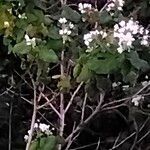Shrub up to about 7 m tall, much branched and bushy, wood softish; young branches hispid, with long patent hairs. Leaf-blade up to 270 x 210 mm or more, ovate to very broadly ovate or orbicular, usually (3-)5-7-9-lobed, but often entire near the inflorescence, lobed up to a quarter of the way, lobes acuminate except the basal ones which are blunt or acute, apex acuminate, base cordate, margin irregularly crenate, with hispidulous hairs on both sides, some hairs simple, some stellate, sometimes with additional short crisped hairs on the main nerves, 7-11-nerved from the base; petiole up to 150 mm long or more, patently hispid; stipules up to 15 mm long, subulate, hispid. Flowers white in about 20-flowered extra-axillary pedunculate umbels towards the ends of the branches; peduncles patently hispid with long hairs, up to about 100 mm long; pedicels similar but about 30 mm long, articulated in the upper half and often more densely hairy; bracts up to 15 mm long, linear with a subulate apex, hispidly hairy. Sepals white, membranous, about 17 x 4 mm, lanceolate, apex acute, pilose with long simple hairs and short stellate hairs outside. Petals white, about 25 x 15 mm, obovate. Stamens very numerous with many outer ones sterile and moniliform in the upper half, fertile stamens numerous with many outer ones sterile and moniliform in the upper half, fertile stamens numerous also; filaments about 10 mm long, barren filaments yellow with purple tips, fertile filaments purple. Ovary ovoid, densely setulose; style abput 10 mm long, glabrous; stigma very minutely 4-5-toothed. Capsule about about 20 mm in diam. including the bristles, subglobose, sparsely setulose; bristles about 17 mm long, with a rigid setulose tip, glandular; seeds dark brown, about 3.5 x 2.5 mm, ellipsoid and tapering to one end; testa rugulose.
More
Shrub, 2-7 m high; young branchlets hispid with long, patent hairs. Leaves ovate to orbicular, apex acuminate, base cordate, margins irregularly crenate. Inflorescences at ends of branches, of ± 20-flowered extra-axillary umbels; peduncles patently hispid. Flowers ± 25 mm long, white. Sepals white, membranous, lanceolate. Petals obovate. Flowering time Nov.-Feb. Fruit a subglobose capsule, with bristles ± 17 mm long.
Shrub or small tree to 7 m, stiffly hairy when young. Leaves coarsely hairy, cordate, toothed. Flowers drooping in umbels, white. Capsules bristly.


